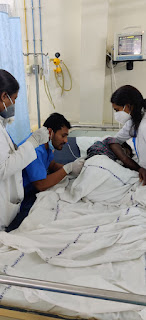November exam
2) A 55 year old male, shepherd by occupation, presented to the OPD with the chief complaints of fever (on and off), loss of appetite, headache, body pains, generalized weakness since 2 months, cough since 2 weeks and vomitings and pain abdomen since 2 days.
https://aakansharaj.blogspot.
A) Where are the different anatomical locations of the patient's problems and what are the different etiologic possibilities for them? Please chart out the sequence of events timeline between the manifestations of each of these problems and current outcomes.
ANATOMICAL LOCATIONS WITH ETIOLOGY:
1) Bone marrow - due to marrow infiltration anemia,leucopenia,thrombocytopenia
2)lytic bone lesions pepper pot skull
3)renal failure - Excess monoclonal immunoglobulin can cause hyperviscosity, platelet dysfunction and renal tubular damage, leading respectively to neurologic derangement, bleeding, and renal failure.
excess production of monoclonal light chains (light- chain cast nephropathy), deposition of intact light chains causing nephrotic syndrome, light chain amyloidosis, hypercalcemia, hyperuricemia, dehydration.
These patients can also have bleeding manifestations due to thrombocytopenia and anitbody coated platelets which are defective.
5) Head ache ,paresthesia and blurring of vision- are features of hyper viscosity.
6) Lungs : showing Moderate to gross right pleural effusion and Multilobar consolidations of the right lung, involving upper and middle lobes With Passive collapse of basal segments of right lower lobe .
Pneumonia is because of immunodeficiency state ,as the immunoglobulins produced are defective.
Pleural fluid analysis showing exudative picture suggesting parapneumonic effusion.
Sequence of events:
Alcohol & smoking (35 years)
Stopped alcohol (4 years)
Fever , generalised weakness & anemia - 2 units blood transfusion (1.5 years)Stopped smoking (4 months)
Low grade fever , generalized weakness , headache , neck pain , loss of appetite , weight loss (2 months)
Cough & SOB (2 weeks)
Vomiting & pain abdomen (2 days)
Outcomes:
Myeloma patient outcomes have improved in the last two decades following the introduction of proteasome inhibitor and immunomodulatory drug therapies.
The relative importance of factors predicting outcome for ...www.nature.com › leukemia › articles
B) What are the pharmacological and non pharmacological interventions used in the management of this patient and what are the efficacy of each one of them?
Pharmological
1.ANTIBIOTICS : For underlying infection (Azithromycin for ?Atypical pneumonia)
2.ATT : For TB
3.SEVELAMER : For hyperphosphatemia
4.FEBUXOSTAT : For hyperuricemia
5.PRBC transfusion for anemia
CASE : 1
1) "55 year old male patient came with the complaints of Chest pain since 3 days Abdominal distension since 3 days Abdominal pain since 3 days and decreased urine output since 3days and not passed stools since 3days.
https://sreejaboga.blogspot.
A) Where are the different anatomical locations of the patient's problems and what are the different etiologic possibilities for them? Please chart out the sequence of events timeline between the manifestations of each of these problems and current outcomes.
ANATOMICAL LOCATIONS WITH ETIOLOGY:
The anatomical location is the inflammation to pancreas secondary to gallstones, alcoholism and hyperlipidemia.
SEQUENCE OF EVENTS:
Congenital bow leg deformity
Alcohol & smoking (30 years)
Abdominal pain & distention , SOB , chest pain , decreased urine output (3 days)
B) What are the pharmacological and non pharmacological interventions used in the management of this patient and what are the efficacy of each one of them?
Antibiotics in acute pancreatitis is not advisable as it’s an inflammatory process. Antibiotics have only been advised in few cases of pancreatic necrosis.
The main stay of treatment is fluid therapy, analgesia for the pain.
1.FLUID REPLACEMENT :
Increased vascular permeability in acute pancreatitis causes the loss of intravenous fluid and reduces plasma volume. In severe cases, in patients with massive ascites, pleural effusion, and retroperitoneal and mesenteric edema, circulating plasma volume decreases markedly. Hypovolemia may lead to shock and acute renal failure, and, because hypovolemic shock may impair the pancreatic microcirculation and promote pancreatic ischemia and necrosis, restoration and maintenance of plasma volume is crucial in severe acute pancreatitis.
2.ANTIBIOTICS : No role in non necrotizing / sterile pancreatitis
3.TRAMADOL : For pain management
4.ZOFER : For vomitings
5.PANTOP : To prevent gastritis and further damage to pancreas by inhibiting gastrin
6.LASIX : For fluid overload
7.NEBULIZATION : For wheezing and crepts
CASE : 3
3) 51 Year old man with complaints of B/L pitting pedal edema from 5 to 6months,abdominal distension from 2 to 3 days,SOB from 3days.
nithishaavula.blogspot.com/
A) Where are the different anatomical locations of the patient's problems and what are the different etiologic possibilities for them? Please chart out the sequence of events timeline between the manifestations of each of these problems and current outcomes.
ANATOMICAL LOCATIONS WITH ETIOLOGY:
The anatomical location is the heart. Diabetes mellitus, hyperlipidemia and hypertension are risk factors for heart failure
SEQUENCE OF EVENTS:
Preload reducing agents - Diuretics (only if symptomatic)
Afterload reducing agents - vaso dilators ,ace inhibitors and arb
Beta blockers for preventing cardiac remodeling and reduce mortality.
Non-pharmological
Salt and fluid restriction
4) 31 yr old man with B/L pedal edema with scrotal and penile swelling since 2 months
https://nairaditya97.blogspot.
A) Where are the different anatomical locations of the patient's problems and what are the different etiologic possibilities for them? Please chart out the sequence of events timeline between the manifestations of each of these problems and current outcomes.
ANATOMICAL LOCATIONS WITH ETIOLOGY:
HEART FAILURE (pedal edema , penile & scrotal swelling and SOB) :
Etiology: Alcohol causing wet beriberi
AXONAL SENSORY POLYNEUROPATHY:
Etiology: Alcohol
b) What are the pharmacological and non pharmacological interventions used in the management of this patient and what are the efficacy of each one of them?
Thiamine
Pantoprozole.
Lasix
Salt restriction
Fluid restriction

Comments
Post a Comment